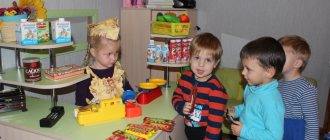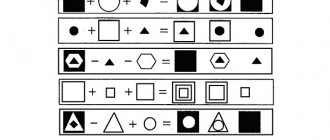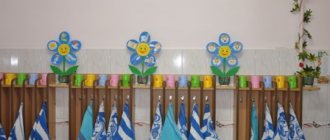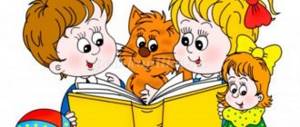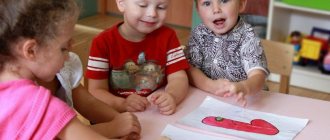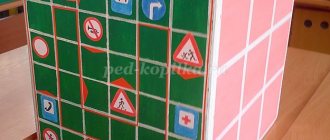Summary of a lesson on FEMP in the junior group according to the Federal State Educational Standard "Lesson in mathematics in kindergarten."
Lesson notes on FEMP in the second junior group according to the Federal State Educational Standard
Mathematics classes in kindergarten. Junior group
Lesson No. 1
Program content
• Improve the ability to compare two equal and unequal groups of objects, use expressions equally, as much as, more, less.
• Reinforce methods for comparing two objects in length and height, and indicate the results of the comparison with appropriate words.
Didactic visual material
Demo material
. High red and low blue gates, chairs (one more than the number of children).
Handout.
Striped paths of green and yellow colors of different lengths, cars (2 for each child).
Guidelines
Part I
. The teacher asks the children to put stripes of paths in front of them and show them the long and short paths. Then he offers to drive the car along a long (short) path, naming its length. (Previously, children clarify how to compare objects by length and the sequence of actions.)
The teacher places high and low gates on the carpet and asks: “What can you say about the height of the gates? Show me the tall gate. Show me the low gate."
The teacher invites the children to crawl under the high gates and crawl under the low ones. Then asks: “What about the height of the red gate compared to the height of the blue gate?”
Part II.
Game exercise “Cars and garages”.
The teacher places “garages” (chairs) in a row. At the teacher's signal, the children begin to roll cars to the music. They move them in the direction indicated by the teacher (turn right, left, move in a circle). After the music ends, the children put the cars in the “garages” (on chairs).
The game is repeated twice. Each time the teacher removes or adds one “garage,” creating a situation of inequality in groups of objects. Children, together with the teacher, find options for establishing equality.
Lesson No. 2
Program content
• Practice comparing two groups of objects using the methods of superimposition and application, using words as much - as, more - less.
• Strengthen the ability to distinguish and name parts of the day: day, night.
Didactic visual material
Demonstration material.
Flannelograph, 5 birds, 5 grains, a picture of a playing child, a picture of a sleeping child.
Handout
. Single-page cards; pictures depicting birdhouses without windows (5 pieces for each child); circles (one less than birdhouses).
Guidelines
Part I
. Educator. Spring has come, birds have flown in from warm countries. (Attach pictures of birds to the flannelgraph.) How many birds flew in? Let's feed the birds grains. (The called children put a grain for each bird.) How many birds? How many grains? Does every bird have a seed? What are more - birds or grains? Which is smaller - grains or birds? How to make sure that there are equal numbers of birds and grains?
Entertaining material for teaching elementary mathematics to preschoolers in the senior group
Elena Rodkina
Entertaining material for teaching elementary mathematics to preschoolers in the senior group
Teacher of MBDOU No. 79 Tomsk Rodkina Elena Aleksandrovna.
I noticed that ingenuity, puzzles, and entertaining games arouse great interest among the guys in my group . Children can, without being distracted, practice for a long time counting objects, transforming figures, rearranging sticks or other objects according to a pattern, according to their own design. In such activities, important qualities of the child’s personality are formed: independence, observation, resourcefulness, quick wits, perseverance is developed, and constructive skills are developed. skills.
Entertaining math games allow you to:
1. cover the widest possible range of mental processes, ranging from such relatively simple ones as spatial perception to more complex ones (imagination, mental analysis, comparison, inference, etc.)
2. stimulating the development of mathematical abilities .
3. development of the ability to observe and compare, contrast and
analyze.
4. develop constructive thinking
5. promote the development of fine motor skills, thereby stimulating the development of the child’s speech and intelligence.
In classes on the formation of elementary mathematical concepts, such material is included in the course of the lesson itself or used at the end of it.
Outside of school hours, entertaining mathematical games, along with others, can be used to organize children’s independent activities based on their interest.
Math games
1 “Guess the number” (for older preschoolers )
Goal: Consolidation of knowledge of the number series. Strengthening children's ability to compare numbers.
According to the task, the child must name a number that is less than or greater than a certain number, the “neighbors” of the number. What number is between the numbers?
2 "Geometric mosaic"
,
“Make a picture” (Picture from geometric shapes)
Purpose: Consolidate ideas about geometric shapes.
Objectives: To develop the ability to sort geometric shapes into groups according to qualitative characteristics. Develop attention, logical thinking, fine motor skills. Foster interest in mathematical development .
3 "Number series"
The purpose of this task is to consolidate knowledge of the sequence of numbers in the natural series.
4 Mathematical entertainment - various tasks, games - “Tantram”, “Pythagoras” puzzle, “Columbus Egg”, “Magic Circle”, “Vietnamese Game”.
5 Labyrinths, to solve which you need to solve a practical problem: help a squirrel find its hollow, a girl get out of the forest, feed animals, etc.
Goal: To develop in children perseverance and the ability to concentrate, logical thinking, and dexterity.
6 “Arrange the circles”
Goal: to develop logical thinking, imagination, attention, fine motor skills. The circles need to be placed in a certain order, following the assignment. For example: arrange the circles so that the blue circle is to the right of the red one, and the small yellow circle is to the left of the blue one, etc.
7 “Make a figure from sticks” (games with counting sticks)
Goal: The ability to rearrange sticks to create geometric shapes and images.
Objectives: To develop the ability to achieve the desired result. Develop logical thinking, imagination, memory. To develop the ability to use acquired knowledge in independent activities.
8 “Sticks (strips)
Cuisenaire" Colored Cuisenaire counting sticks are used to develop children's
mathematical abilities and prepare for mathematics lessons at school.
Purpose: to consolidate, with the help of Cuisenaire sticks, the composition of numbers, counting, and to consolidate the number series.
9 Logic problems to find missing figures (Find the ninth)
From the figures, choose the one that can be placed instead of a question mark.
The purpose of such tasks is to arouse interest in solving a problem through visual and mental analysis of rows of figures horizontally and vertically.
10 “Count and put the number”, “Count and answer”
Goal: To teach children quantitative calculation, to teach them to correlate the number of objects with a number.
11 "Dyenes Blocks"
Goal: Development of sensory and sign culture.
Objectives: Development of ideas about the properties of objects (blocks)
– shape, size, color, thickness.
To form an understanding of connections and relationships in the natural series of numbers. To develop logical operations: comparison, seriation, classification. Foster interest in mathematical development .
12 Nikitin’s cubes B. P. “Steps of creativity, or educational games”
Goal: To promote children's mastery of elementary modeling .
Objectives: Consolidate knowledge of colors, shapes, develop the ability to combine objects. Formation of the ability to classify figures by shape and color. Develop the ability to find your own solution.
Game entertaining tasks for preschoolers
Page 1 of 12Next ⇒
The manual contains entertaining material with mathematical content (games, puzzles, etc.) for working with children 4-7 years old
About the book
From the author
Entertaining material for teaching elementary mathematics to preschoolers
Math games
Using fun material in math classes
Training in solving problems using ingenuity (puzzles)
Examples (for children 5-6 years old)
Examples (for children 6-7 years old)
Logical exercises and tasks in teaching children mathematics
Examples (for children 5-6 years old)
Examples (for children 6-7 years old)
Games for recreating figurative and plot images from geometric shapes
Examples (for children 6-7 years old)
Examples (for children 6-7 years old)
Puzzle game "Pythagoras"
Riddles, joke problems, entertaining questions in teaching children in the classroom
Fun math material for working with children outside of class
Organization of entertaining mathematics corners
Games and exercises for children 4-5 years old
Games and exercises for children 5-6 years old
Evening of entertainment “Journey to Wonderland” (for children 5-6 years old)
Games, mathematical entertainment for children 6-7 years old
Consultation
How to organize children's games at home using fun math material
Approximate topics for parent meetings (conversations and consultations)
What to read
Source:
Mikhailova Z.A. 'Game entertaining tasks for preschoolers' - Moscow: Education, 1985 - p.96
From the author
To successfully master the school curriculum, a child needs not only to know a lot, but also to think consistently and convincingly, to guess, and to show mental effort. Intellectual activity, based on active thinking and searching for ways to act, can become habitual for children already in preschool age under appropriate conditions.
As is known, a child exhibits special mental activity in the course of achieving a gaming goal, both in class and in everyday life. Game-based entertaining tasks are contained in various types of exciting mathematical material. In the history of the development of methods for teaching children mathematics, quite a lot of similar material has been accumulated, some of it is accessible to preschoolers.
The manual contains tasks, games, and puzzles for working with children aged 4-7 years. The material is presented in a certain system, which is important for increasing the level of general mental development of children, preparing them for mastering a mathematics course at school, and for creative work in the future.
Entertaining mathematical material is also considered as one of the means that ensures a rational relationship between the teacher’s work in and outside the classroom.
In classes on the formation of elementary mathematical concepts, such material is included during the lesson itself or used at the end of it, when there is a decrease in the mental activity of children. Thus, puzzles are useful for consolidating children’s ideas about geometric figures and their transformation in middle, high school and preparatory school groups. Riddles, joke problems are appropriate in the course of learning to solve arithmetic problems, operations with numbers, the formation of temporary representations, etc. At the very beginning of classes in senior and preparatory school groups, the use of simple entertaining problems as “mental gymnastics” is justified.
During extracurricular time, the teacher uses entertaining mathematical games, along with others, to organize children’s independent activities based on their interest. The forms of organization of children are varied: games are held with the entire group of students, with subgroups and individually. Pedagogical guidance consists of creating conditions for games, maintaining and developing interest, encouraging independent searches for solutions to problems, and stimulating creative initiative.
The content of the manual includes games that have been tested in working with preschool children in the context of public and family education.
Ingenuity, puzzles, and entertaining games arouse great interest among the children. Children can, without distraction, practice transforming figures for a long time, rearranging sticks or other objects according to a given pattern, according to their own ideas. In such activities, important qualities of the child’s personality are formed: independence, observation, resourcefulness, intelligence, perseverance is developed, and constructive skills are developed.
In the course of solving ingenuity problems and puzzles, children learn to plan their actions, think about them, guess in search of a result, while showing creativity. This work activates not only the child’s mental activity, but also develops in him the qualities necessary for professional excellence, no matter in what field he later works.
The “Main Directions for the Reform of General Education and Vocational Schools” outlines a program for further improvement of the upbringing and education of children: “It is necessary to improve the organization of the upbringing and education of preschool children. From an early age, instill in them love for the Motherland, respect for elders, camaraderie and collectivism, a culture of behavior, a sense of beauty, develop in each child cognitive interests and abilities, independence, organization and discipline" (On the reform of secondary and vocational schools. Collection of documents and materials. M., 1984, p. 54). We hope this guide will help you solve these problems.
Entertaining material for teaching elementary mathematics to preschoolers
In the history of the development of preschool didactics and methods for the formation of mathematical concepts, the place and role of entertaining material (The entertaining material available in this manual was borrowed with minor changes from domestic and foreign publications. Some games and exercises with mathematical content were developed by the author) were considered from different positions. At the beginning of our century, when there were no special works aimed at revealing the issues of methods of teaching mathematics to preschoolers, the simplest entertaining material was included in general collections on entertaining mathematics. It was pointed out that it could be used to prepare children for school and develop ingenuity. In tasks of varying degrees of complexity, entertainment attracts children's attention, activates thought, and arouses sustained interest in the upcoming search for a solution. The nature of the material determines its purpose: to develop children’s general mental and mathematical abilities, to interest them in the subject of mathematics, to entertain, which is, of course, not the main thing.
Any mathematical ingenuity problem, no matter what age it is intended for, carries a certain mental load, which is most often disguised by an entertaining plot, external data, task conditions, etc.
The mental task: to make a figure, modify it, find a solution, guess a number - is realized through the means of the game, in game actions. The development of ingenuity, resourcefulness, and initiative is carried out in active mental activity based on direct interest.
What makes mathematical material interesting is the game elements contained in every problem, logic exercise, and entertainment, be it chess or the most basic puzzle. For example, in the question: “How to make a square on a table using two sticks?” — the unusualness of its production makes the child think in search of an answer, get involved in the play of imagination.
The variety of entertaining material - games, tasks, puzzles - provides the basis for their classification, although it is quite difficult to divide such diverse material created by mathematicians, teachers, and methodologists into groups.
It can be classified according to various criteria: by content and meaning, the nature of mental operations, as well as the sign of generality, focus on the development of certain skills.
Based on the logic of the actions carried out by the decider, a variety of elementary entertaining material can be classified into 3 main groups: entertainment, mathematical games and tasks, educational (didactic) games and exercises. The basis for identifying such groups is the nature and purpose of the material of one type or another.
How can you represent this in a diagram?
Entertaining math material
| Entertainment | Mathematical (logical) games, tasks, exercises | Didactic games and exercises |
| Riddles, joke tasks, | With blocks, cubes to turn on, find | With visual material |
| puzzles, math squares, math tricks | Checkers, chess | Verbal |
| “Tangram”, “Stomachion”, “Hexatrion”, “Pythagoras”, “Columbus Egg”, “Cubes for All” | Verbal |
1. Collections of entertaining mathematics widely present mathematical entertainment: puzzles, numerical curiosities, labyrinths, games on spatial transformation, etc. They are interesting in content, entertaining in form, distinguished by the unusualness of the solution, the paradoxical nature of the result. For example, puzzles are represented by arithmetic (guessing numbers), geometric (cutting, with wire), alphabetic (anagrams, crosswords, charades), ancient puzzles designed to play with fantasy and imagination.
Let's look at other types of entertaining material.
Math games
Games in which mathematical constructions, relationships, and patterns are modeled are considered mathematical. To find an answer (solution), as a rule, a preliminary analysis of the conditions, rules, and content of the game or task is necessary. The solution requires the use of mathematical methods and inferences or similar.
Chain of examples
(The game is offered for individual work with children 6-7 years old who have successfully mastered the program material on the development of elementary mathematical concepts)
Target. To train children in the ability to perform arithmetic operations.
Progress of the game. Two groups of participants sit on chairs - one opposite the other. One child takes the ball, says a simple arithmetic example: 3+2, and throws the ball to someone from the other group. The one to whom the ball is thrown gives the answer and throws the ball to the player from the first group. The one who caught the ball continues with the example, which must perform an action with the number that is the answer in the first example: add, subtract, multiply, etc. The participant in the game who gave the wrong solution and named an example, the solution of which produces a non-integer number or a number that cannot be subtract, is eliminated from the game. The group of children with the most players left wins
Guess the number
(for older preschoolers)
Target. Strengthen children's ability to compare numbers.
Progress of the game. According to the leader’s instructions, the child must quickly name the number(s) less than 8 but greater than 6; more than 5, but less than 9, etc. The child who fulfills the conditions of the game receives a flag. When dividing children into 2 groups, the one who answered incorrectly is eliminated from the game.
Both games are simple in content and task; its participants must perform arithmetic operations or name the required number based on knowledge of the sequence and relationship between numbers. Fun and interest are provided by game actions (throwing a ball), game goal setting, rules, and techniques for stimulating mental activity.
A variety of mathematical games and tasks are logic games, tasks, and exercises. They are aimed at training thinking when performing logical operations and actions: “Find the missing figure”, “What are the differences?”, “Mill”, “Fox and Geese”, “Four by Four”, etc. Games - “Growing a Tree”, “Miracle” -bag”, “Computing machine” - imply a strict logic of action.
Only one property
(for older preschoolers)
The material for the game is geometric shapes (circles, squares, triangles, rectangles) of four colors and two sizes. To play the game you need to make a special set of geometric shapes. It includes four shapes (circle, square, triangle and rectangle) in four colors such as red, blue, yellow and white in small size. The same set includes the same number of listed figures of the indicated colors, but larger in size. Thus, for the game (per participant) you need 16 small geometric shapes of four types and four colors and the same number of large ones.
Target. To consolidate knowledge of the properties of geometric shapes, develop the ability to quickly select the desired shape, and characterize it.
Progress of the game. Two playing children each have a full set of figures.
One places any piece on the table. The second player must place a piece on the table that differs from it in only one attribute. So, if the first player puts a large yellow triangle on the table, then the second puts a large yellow square or a large blue triangle, etc. A move is considered incorrect if the second player places a piece that does not differ from the first or differs from it in more than one attribute. In this case, the piece is taken from the player. The one who is the first to be left without pieces loses. (Options are possible.)
The game is built like a domino. As the game progresses, the players need to quickly orient themselves in color, shape, and size of the figures, hence the... influence on the development of logic, validity of thinking and actions.
3. Entertaining material also includes various didactic games and exercises that are entertaining in form and content. They are aimed at developing logical thinking and spatial concepts in children of different ages, and provide an opportunity to train children in counting and calculations.
Number series
(for children of senior preschool age)
Target. Reinforce knowledge of the sequence of numbers in the natural series.
Progress of the game. Two children play, sit at the same table, lay out all the cards with numbers from 1 to 10 face down in front of them. In this case, each of the children is given a certain number of cards with numbers (for example, up to 13).
Some of the numbers appear twice in the set. Each player in order takes a card with a number, opens it and places it in front of him. Then the first player reveals another card. If the number indicated on it is less than the number of the card he opened earlier, the child places the card to the left of the first, if more, to the right. If he takes again a card with a number that he has already opened, then he returns it to its place, and the right to move is transferred to his neighbor. The one who lays out his row first wins.
We can conditionally distinguish 2 more large groups of games and exercises. The first includes all mathematical problems, games of ingenuity.
Name the number
Target. To train children in the ability to perform mental calculations.
Progress of the game. An adult or older child says: “I can guess the number you have in mind. Think of a number, add 6 to it, subtract 2 from the sum, then subtract the number you thought of, add 1 to the result. You get the number 5.”
In this simple ingenuity task, the number in mind can be any, but to solve it you need to be able to calculate verbally.
Solving problems of the second group does not require special mathematical training; only resourcefulness and intelligence are needed.
How many candies should I take?
(The game is recommended for individual work with children who have successfully mastered knowledge of the program material in elementary mathematics)
Target. Exercise children in correlating the conditions of the task with the result.
Progress of the game. The condition of the problem is proposed: “There are 2 types of candy in a paper bag. They take several candies at random. What is the smallest number of candies you need to take so that among them there are at least 2 candies of the same type? (At least 3.) The problem is solved through logical thinking.
The problem about apples is solved in the same way: “There were three apples in the vase. Mom treated them to three girls. Each of the girls received an apple, and one remained in the vase. How did it happen?" The problem solver comes to the answer through reflection and correlation of conditions with the result. One girl took the apple along with the vase.
Mathematical entertainment is represented by various kinds of tasks, exercises, games on spatial transformations, modeling, recreation of silhouette figures, figurative images from certain parts. They are exciting for children. The decision is made through practical actions in compiling, selecting, and arranging according to the rules and conditions. These are games in which you need to create a silhouette figure from a specially selected set of figures, using the entire proposed set of figures. In some games, flat figures are made: “Tantram”, “Pythagoras” puzzle, “Columbus Egg”, “Magic Circle”, “Pentamino”. In others, you need to create a three-dimensional figure: “Cubes for everyone”, “Chameleon Cube”, “Assemble a prism”, etc.
Entertaining mathematical material is very diverse in nature, topic, and method of solution. The simplest tasks, exercises that require resourcefulness, ingenuity, originality of thinking, and the ability to critically evaluate conditions, are an effective means of teaching preschool children in mathematics classes, developing their independent games, entertainment, during extracurricular time.
1Next ⇒
Recommended pages:
Use the site search:
Topic: “The Road to the Land of Mathematical Knowledge.”
Goal: to consolidate knowledge of forward and backward counting within 20, the ability to establish connections and relationships between numbers in the natural series, the composition of a number from two smaller numbers, to consolidate the ability to navigate on a sheet of paper, to develop tactile sensitivity; continue to teach how to establish the dependence of a number on the size of the object being measured using a conventional measure; continue to develop the operational side of thinking, intelligence, and ingenuity.
Materials: ball, sheet of paper with images of geometric shapes, cards with numbers, geometric shapes, boards with numbers, ribbons of different lengths, cards with buttons, counting sticks.
Progress of the lesson
Children enter the hall to the music. The song “What do they teach at school?” plays.
Q. Children, what do they teach in school? (Children's answers.) Those who cross the threshold of the school find themselves in a magical land - the Land of Knowledge. This country is ruled by a wise and fair Queen. But to get there, you need to get a pass, which can only be issued by the Queen herself.
Guys, I really want you all to be accepted into school. And this morning I received a package, and in it was this letter.
Maxim, please go and read this letter. Where did it come to us from?
The child reads: “Guys, in order to get into my country and get a pass, you need to complete my tasks. If you succeed, you will be able to build a road to the Land of Knowledge. Queen of the Land of Knowledge."
Q. Guys, there are a lot of tasks, so let’s try to answer quickly and correctly.
Listen to the first task.
Game "Keep counting".
Goal: consolidate the quantitative score to 20.
Q. The one to whom I throw the ball begins to count, after the word “stop” he throws the ball back, and the next one who has the ball continues counting from the number where the previous one stopped. Having counted to 20, count back.
You have completed this task, and we begin to build the path. And now the next task.
Game "Forbidden Number".
Goal: to develop attention, imagination, counting.
Our forbidden number will be “7”. We only count to 10, be careful. Whoever leaves the game goes to the board and draws something, write your name under it.
Well done, you did well. But Sergei was the most attentive. He gets the right to find and place the next plank of the path.
Game "Neighbors and the Missing Number".
Goal: to consolidate knowledge about the sequence of numbers in a number series.
Q. I show you a number, and you name its neighbors and the number missing between them.
We completed the task. Go, Alina, continue building the path. And you, children, see if she placed the board with the number correctly.
Game “Only one property” (to music).
Goal: classify geometric shapes according to one criterion.
Q. Guys, how many children do we have in our group today? We need to split into two teams to make it evenly divided.
Task for the first team (the second checks):
- find and place all the figures of the same size;
- the first team will place all the pieces of the same shape;
- the second command will place all the pieces that have corners.
Here's another task completed. Go, Tanya, put down the board with the corresponding number.
Game "Riddles".
Goal: to develop attention, intelligence, logical thinking.
Q. Children, now I will make a riddle about one of the objects shown in the picture, and you must guess by asking me questions.
Now tell me in words, where is the answer on the piece of paper? (In the upper right corner.)
Game “There were hares on the mountain.”
Goal: to consolidate knowledge of numbers, the ability to correlate numbers with the number of fingers.
Q. When the music plays, you dance. As soon as the music stops, you look at what number I will show you, and show the same number of fingers, but so that the fingers of both hands participate.
How many fingers did you, Tanya, show on your right and left hand? What numbers does the number 6 consist of? Etc.
Well done! Go, Zhenya, put down the board with the corresponding number.
Game "Answer quickly."
Goal: to develop attention, intelligence, thinking.
Q. Now you must quickly answer the questions:
- What seasons of the year do you know?
- What is the name of the second month of spring?
- How many months are there in a year?
- What happens in winter?
- What is round?
- Alena is with her grandmother all summer, and Kolya is with her all year. Who was with grandma more?
- What time of year occurs after spring?
You answered the questions correctly, so you get the opportunity to continue building the track.
Now let's rest a little.
